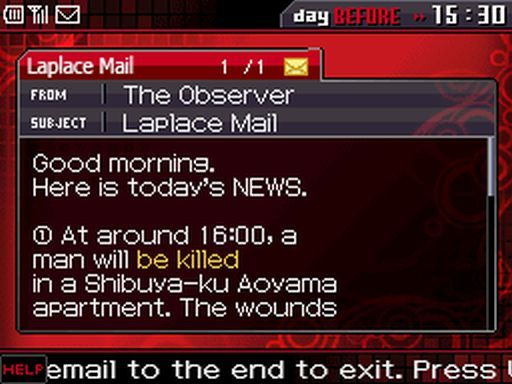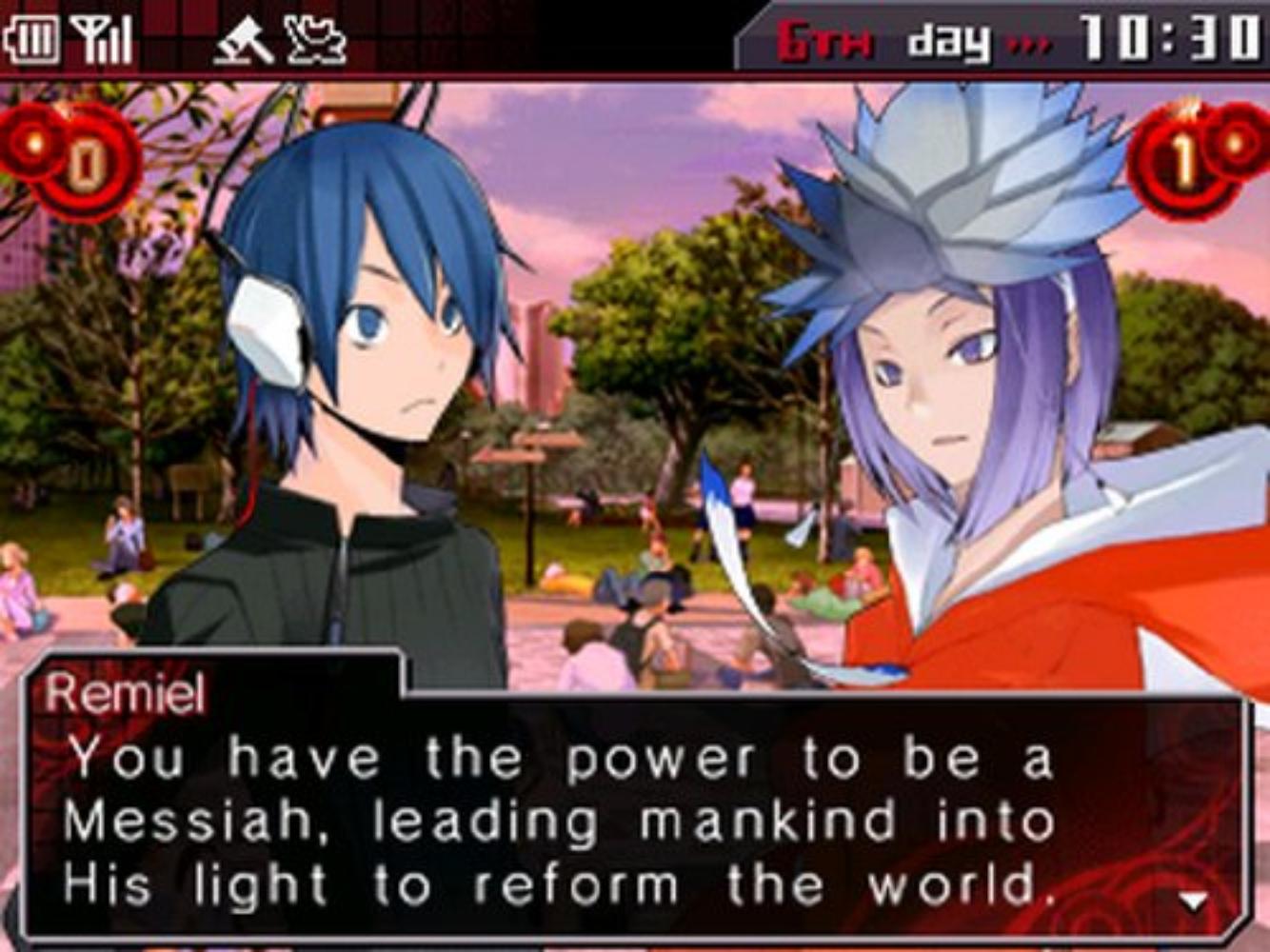Shin Megami Tensei: Devil Survivor and Laplace's Demon Thought Experiment
Comparing Shin Megami Tensei's plot with the famous philosophical experiment

Developed and published by Atlus in 2009, and directed by Shinjirō Takata, Shin Megami Tensei: Devil Survivor (DS) is a tactical RPG set in Tokyo in the 2000s. The game presents a lockdown in an area where a demonic seven-day survival game will take place to decide the future of humanity. With this premise, the plot appropriates Laplace’s Demon thought experiment as a computer capable of anticipating events during this survival game called War of Bel.
This is not the first time that the Shin Megami Tensei series has worked with philosophical concepts. In fact, this is a recurrence in this franchise. For example, as I've shown in another article, Shin Megami Tensei III is largely designed around ideas like "will to power" and Übermensch ("superman" or "beyondman"), developed in Thus Spoke Zarathustra by Friedrich Nietzsche. As in that applied essay in political philosophy from SMT III, today I explain how Laplace's Devil experiment is mobilized in Devil Survivor.
Laplace's Demon
Let's start with the theory. A common belief in our everyday experience is that we humans enjoy what in the areas of philosophy and cognitive sciences is called “free will”.
For this brief essay, we can introductory understand this concept as the ability to choose between different courses of action without hindrance. This notion is very important for theology, ethics, legal sciences and other areas, because, in the hard deterministic hypothesis that there is no free will, it becomes problematic to attribute guilt, sin and other attributions of responsibility to human beings.

One of the most classic ways of denying human free will is through a thought experiment proposed by philosopher, mathematician, and physicist Pierre-Simon Laplace. In his philosophical essay on probability — Essai philosophique sur les probabilités (1814) — the Marquis de Laplace proposes that we accept two premises:
- An intelligence capable of storing and calculating all the variables of the universe in a state of the universe, in a present time t;
- That everything in this universe works deterministically according to the laws of Newtonian physics.
Given these premises, the conclusion is that this intelligence (the “Laplace demon”, as they nicknamed it) would know exactly what the universe would be like at a later time t'.
As many noted in his time — particularly theologians —, this argument was potentially dangerous and catastrophic, as it resulted in humans' actions being determined, not really arising from their choices. The intention and consciousness of a human to act in a certain way would, in fact, only result from limitation and illusion in the lack of science about all the variables that would determine what would be his action practiced.

In other words, everything in the universe would be predictable, like a perfectly calibrated clock. If one day we could, for example, make a computer capable of being Laplace's demon, it could know exactly whether you, dear reader who is reading this text, will read it to the end or not, if after that you will play Devil Survivor or not, and much more.
However, things are not as simple as Laplace would have liked, and in the following centuries, many obstacles have arisen to his two premises. While studies in physics, in the fields of thermodynamics, chaos theory, and quantum mechanics showed the universe was not as deterministic and/or predictable as was believed in the early 19th century, studies in philosophy, mathematics, and logic showed the impossibility of to exist or to create the supposed Laplacian intelligence. However, it is still an important and inspiring historical topic for discussions about causal determinism, and SMT: Devil Survivor has appropriated it to create a unique experience.
The Laplacian Computer and the War Between Angels and Demons
In the late 2000s, Atlus brought to life a new spin-off of the Shin Megami Tensei series that would perfectly match Laplace’s experiment. This spin-off, Devil Survivor, targeted teens and young adults with a simple tactical level design and a fresh plot approach from the series’ four main brands: setting in contemporary Japan; flexible narrative design based on choices; religious and philosophical themes; and combat system and fusion with demons.
In the plot's course, in a lockdown region of Tokyo, the Protagonist (named by the player) and his allies discover that a local demonic outbreak results from a planned battle between angels and demons, judging the value of humanity. The deal between angels and demons states that if humans do not stop the demons within seven days, the angels should destroy humanity.


Shin Megami Tensei: Devil Survivor Overclocked (3DS). From left to right: (1) Source: Nintendo Blast; (2) Source: jrpg.moe.
The Japanese government was aware of this event for years and enacted the PSE Act as a safeguard, which built certain electromagnetic remote control devices into all consumer electronics. Besides the lockdown, this was done so that in case the outbreak of demons could not be stopped, the government could use them as a last resort to destroy the living beings within the quarantine (human and non-human), being willing to practice a “necessary sacrifice”.
In this proposal, Shinjirō Takata (director of the Langrisser series) not only knew how to make a unique TRPG gameplay for this series but also masterfully articulated the philosophical concepts discussed in the previous topic to give coherence to Devil Survivor's design. The protagonists have the average age of the target audience (17 years old), and use devices such as cell phones and the COMP (very similar to a DS), a device capable of capturing, summoning, and taming demons. In possession of these devices, humans in lockdown tried to auction off demons in this region, establishing a survival economy. Meanwhile, on the other side of the DS screen, the player reasons tactically in combat and morally in his choices, in line with the game's philosophical problem.


From left to right: (1) Source: Nintendo Blast; (2) Source: Reddit.
In this premise, it was opportune to explore the concept of internet, hacking, and computability in favor of Laplace's argument, in addition to a controlled scenario, where the variables of actions could be relatively isolated from the rest of the world, hence the idea of placing them in a lockdown region. Finally, the name “demon” came as a bonus to refer to the demonology of SMT. Thus, Laplace's reimagining of the devil experiment appears in SMT: Devil Survivor, primarily in three circumstances:
- Laplace Mail system to deliver missions to the player;
- determinism vs. free will during player choices;
- and computational, political, and religious rereading of Laplace's premises.


From left to right: (1) Source: Nintendo Blast; (2) Source: tumgir.
In Laplace Mail lies the heart of the Devil Survivor proposal. It is a COMP e-mail in which someone called “The Observer” sends a message every morning to the protagonists about things that should happen during that day, which can be significantly changed, depending on the player's choices, preventing or delaying deaths of people, for example. In analogy to the famous Laplace transform, which simplifies and translates differential equations, Laplace Mail translates messages from the underworld into a language understandable to humans who have a COMP.
Still, within this concept of “foreseeing the future”, there is the Death Clock, an ability of the Protagonist to see the remaining days of humans before they die. Based on information from the Laplace Mail and Death Clock — which is possibly based on the same algorithm — the player can avoid deaths and events, making Laplace’s system increasingly inaccurate. In this way, game design choices lead to an experience of abstract confrontation between determinism vs. free will that translates into a concrete confrontation between demons vs. humans, in which the latter aim to win their freedom, discover the government’s intentions, and also show their worth to the angels.


From left to right: (1) Source: Nintendo Blast; (2) Source: Gaming Nexus.
Yoh Haduki and his team of Devil Survivor writers were very competent at embedding pertinent questions about ethics, politics, and religion. It is interesting to note how the religious vision here approaches mythological narratives in which the human appears almost as a “toy” of the deities, and the narrative does not present a “right way”, on the contrary, it encourages the player to play and replay at the same time. This way, testing his moral convictions and leading him to different endings.
However, there are also problems with accuracy. Despite a well-done design job, more attentive readers will notice that there are flaws in Laplace’s depiction of the Demon. First, while the lockdown isolates an area, it does not remove the problems of post-Newtonian physics. It also does not completely isolate the variables from the rest of the world about that place; proof of this is the government’s political actions, so it is difficult to sustain an intelligence capable of computing external variables as well without contradicting the government’s intentions.


From left to right: (1) Source: Nintendo Blast; (2) Source: jrpg.moe.
Second, even if granted by the game’s supernatural premise, it’s also debatable how Laplace Mail grows inaccurate until it finally crashes, as it seems able to revise its calculations over the course of days. Even if it weren’t, by Laplace’s theory, this machine should know in advance the player’s choices, otherwise, it doesn’t actually comprise a Laplace demon, since it doesn’t contain all the variables of the universe, as the experiment assumed.
Despite some problems of incoherence with Laplace's deterministic argument, the game offers an interesting and playful experience on the subject and can serve as support material for anyone interested in the subject, as long as they are aware of its inaccuracies and poetic licenses. Furthermore, it is a title with a great rock OST and with a cohesive and ingenious TRPG design, especially in RPG mechanics and narrative design.

Shin Megami Tensei: Devil Survivor (DS) and its successor, Shin Megami Tensei: Devil Survivor 2 (DS), also have versions for 3DS (the Overclocked and Record Breaker versions, respectively). I recommend all these versions for fans of the genre and, in the opinion of this writer, are also great entries for the Shin Megami Tensei series.
This text was originally published in Nintendo Blast (Portuguese).
